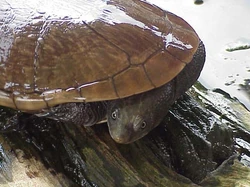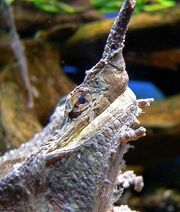| Chelidae | |
|---|---|
 | |
| Physical description | |
| Habitat | Swamps, freshwater lakes, ponds, and streams |
| Lifespan | 70 - 150 years |
| Average Size | 3 to 4.5 inches (7.6 to 11.4 centimeters) - 2 feet (60 centimeters) |
| Average weight | 5 ounces (142 grams) - 10 pounds (5.2 kilograms) |
| Diet | Carnivorous |
| Scientific classification | |
| Kingdom | Animalia |
| Phylum | Chordata |
| Class | Reptilia |
| Order | Testudines |
| Suborder | Pleurodira |
| Family | Chelidae |
| Distribution | |
| Distribution of species | Australia, New Guinea, Indonesia, and South America. |
The Austro-South American Side-necked Turtles of the family Chelidae are one of the three living families of the turtle suborder Pleurodira. The Family is distributed in Australia, New Guinea, parts of Indonesia and throughout most of South America. It is a large family of turtles with a significant fossil history going back to the Cretaceous. The family is entirely Gondwanan in its origin with no members found outside of Gondwana, either in the present day or as a fossil.[1]
Shell morphology[]
| Members of Chelidae have unique shell morphology. The carapace often has reduced surface exposure of neural bones, or even none at all (Thomson & Georges, 1996).[2] This is due to less requirement for enlarged longissimus dorsi muscles in side necked turtles (Thomson, 2003).[3]
The inside of the carapace is often heavily buttressed. This has sometimes been seen as a defense mechanism, that is it increases the strength of the shell against biting force, however Thomson (2003[3]) demonstrated it is linked to feeding methods and the prevention of internal torsion of the shell. Chelid's also lack Mesoplastra which separates them from the Pelomedusidae. The cervical scute is usually present though it is absent in some species of Elseya and Myuchelys. Otherwise the carapace has the usual complement of 4 costals, 5 vertebrals and 12 marginals (per side). Internally the carapace is made of 8 pleurals (per side), 11 peripherals (per side), a nuchal at the front and a suprapygal and pygal at the rear of the shell. As noted earlier neurals although always present often exist as subsurface elements above the vertebral column.[2] The plastron of chelids does not contain any hinges as can appear in some Cryptodire turtles. The scute pattern is a unique feature of the Pleurodira and can be used to immediately identify a shell as belonging to this suborder. All cryptodire's have 12 plastral scutes whereas pleurodires have 13. The extra scute is called the intergular. The rest of the scutes and the skeletal structure beneath them are the same as all turtles: paired gulars, humerals, pectorals, abdominals, and anals. The skeletal elements consist of a single entoplaston, as well as paired epiplastra, entoplastra, hyoplastra, hypoplastra and xiphiplastra (Pritchard & Trebbau, 1984).[4]
 Mata mata - Chelus fimbriatus |
Classification[]

Mata Mata Chelus fimbriatus
The family Chelidae contains approximately 60 species within around 20 genera. Following based on Georges et al. 1998.[5]
Suborder Pleurodira
- Family Pelomedusidae
- Family Podocnemididae
- Family CHELIDAE Gray, 1831[6]
- Subfamily Chelodininae
- Genus Chelodina Fitzinger 1826 – Australian Snake-necked Turtles
- Genus Elseya Gray 1867 – Australian Snapping Turtles[7]
- Genus Emydura Bonaparte 1836 – Australian Short-necked Turtles
- Genus Elusor, Cann & Legler, 1994[8] – Mary River Turtle
- Genus Myuchelys Thomson & Georges 2009[9] – Australian Saw Shelled Turtles
- Genus Pseudemydura Siebenrock 1901[10] – Western Swamp Tortoise
- Genus Rheodytes Legler and Cann 1980,[11] – Fitzroy River Turtles
- Subfamily Chelidinae
- Genus Chelus Duméril 1806 – Matamata Turtles
- Genus Acanthochelys Gray, 1873[12] – South American Side-necked Swamp Turtles
- Genus Mesoclemmys – Gibba Turtle
- Genus Phrynops – Toad-headed Turtles
- Genus Platemys Wagner 1830 – Twisted-necked Turtles
- Genus Rhinemys – Red-headed Sideneck Turtle
- Genus †Bonapartemys Lapparent de Broin and de la Fuente 2001[13]
- Genus †Lomalatachelys Lapparent de Broin and de la Fuente 2001[13]
- Genus †Prochelidella Lapparent de Broin and de la Fuente 2001[13]
- Genus †Palaeophrynops Lapparent de Broin and de la Fuente 2001[13]
- Genus †Parahydraspis Wieland 1923
- Genus †Linderochelys de la Fuente et al. 2007
- Subfamily Hydromedusinae
- Genus Hydromedusa Wagler 1830 – South American Snake-necked Turtles
- Genus †Yaminuechelys de la Fuente et al. 2001
- Subfamily Chelodininae
Phylogeny[]

Phrynops geoffroanus
Relationships of the living forms based on Georges et al., 1998.[5]
| Chelidae |
| ||||||||||||||||||||||||||||||||||||||||||||||||||||||||||||||||||||||||||||||
References[]
- ↑ Georges, A., & Thomson, S. 2006. Evolution and Zoogeography of Australian freshwater turtles. In: Merrick, J.R., Archer, M., Hickey, G., and Lee, M. (eds.), Evolution and Zoogeography of Australasian Vertebrates. Sydney: Australia.
- ↑ 2.0 2.1 Thomson, S. and Georges, A. 1996. Neural bones in chelid turtles. Chelonian Conservation and Biology 2:82-86.
- ↑ 3.0 3.1 Thomson S. 2003. Long necks, flat heads and the evolution of piscivory. World Chelonian Trust
- ↑ Peter C. H. Pritchard and Pedro Trebbau 1984. Turtles of Venezuela. Society for the Studies of Amphibians and Reptiles: 403 pp.
- ↑ 5.0 5.1 Georges, A.; J. Birrell, K. M. Saint, W. McCord und S. C. Donnellan (1998) A phylogeny for side-necked turtles (Chelonia: Pleurodira) based on mitochondrial and nuclear gene sequence variation Biological Journal of the Linnean Society 67: 213-246
- ↑ Gray, J. E. 1831. Synopsis Reptilium or short descriptions of the species of reptiles. Part 1. Cataphracta, tortoises, crocodiles, and enaliosaurians. London. 85 pp.
- ↑ Gray, J.E. (1867) Description of a new Australian tortoise (Elseya latisternum). Ann. Mag. Nat. Hist. (3) 20: 43-45.
- ↑ Cann, J. and Legler, J.M. (1994). The Mary River Tortoise: a new genus and species of short-necked chelid from Queensland, Australia (Testudines; Pleurodira). Chelonian Conservation and Biology 1(2):81-96.
- ↑ Thomson, S. & Georges, A. (2009) Myuchelys gen. nov. — a new genus for Elseya latisternum and related forms of Australian freshwater turtle (Testudines: Pleurodira: Chelidae) Zootaxa 2053: 32–42.
- ↑ Seibenrock, F. 1901. Beschreibung einer neuen schildkrotengattung aus der familie Chelydidae aus Australien: Pseudemydura. Anz. Akad. Wiss. Wien 38:248-251.
- ↑ Legler, J.M. & Cann, J. 1980. A new species of chelid turtle from Queensland, Australia. Contributions to Science (Natural History Museum of Los Angeles County) 324:1-18.
- ↑ Gray, J.E. 1873. Observations on chelonians, with descriptions of new genera and species. Annals and Magazine of Natural History (4)11:289-308.
- ↑ 13.0 13.1 13.2 13.3 Broin, F. de. and de la Fuente, M.S. 2001. Oldest world Chelidae (Chelonii, Pleurodira), from the Cretaceous Patagonia, Argentina. Palaeontology 333:463-470.

